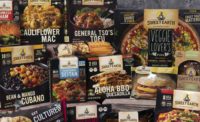Sourcing Strategies for Plant-Based Foods
Why Greenleaf Foods sees sourcing as a key differentiator in a crowded plant-based category.

Several Lightlife and Field Roast products utilize pea protein--a common source of protein for plant-based foods. However, parent company Greenleaf Foods diversifies their protein sources to also include soy, wheat, and fava to add flavor and texture variety, and also to keep pea protein from shouldering the burden environmentally and logistically as a sole source for plant-based products.

"Our collective goal is to help nourish a global population in a better, more sustainable, and more affordable way, using diversified protein options," says Greenleaf Foods President Dan Curtin.

Greenleaf's Lightlife brand recently reformulated their line of plant-based meats for cleaner labels and improved flavor.

Greenleaf's Field Roast brand redesigned its packaging last year to appeal to chefs and home cooks alike as a high-quality option for meatless dishes.

Plant-based foods sold a record $7 billion in 2020, as more consumers adopted a flexitarian diet.





The plant-based foods category—which encompasses a substantial amount of refrigerated and frozen items—had its most successful year ever in 2020, with $7 billion in sales, and a year-over-year increase of 27%, according to the Plant Based Foods Association and SPINS.
One of the category’s most recognizable brands is Greenleaf Foods, our 2021 Refrigerated Foods Processor of the Year, and a pioneer in vegan meats and cheeses, with popular brands Lightlife, Field Roast, and Chao under their umbrella. The company sees ingredient transparency as the future of the category, and a core tenet of its clean-label strategy. We caught up with Dan Curtin, president at Greenleaf Foods, to learn more about how the company procures plant-based proteins for its products, and how that sourcing program helps differentiate the brand among its competition.
R&FF: Why is label transparency for plant-based products important to Greenleaf Foods?
Curtin: Consumers clearly desire more protein in their diet, with more options and variety. This includes a balance of plant-based protein and animal protein sources. Lightlife consumer research shows people’s top-three reasons for choosing plant-based protein are health, sustainability, and variety. That’s why our focus is on delivering a variety of delicious plant-based products made with simple ingredients that allow all dayparts of consumers’ needs to be met. We’re also transparent about our health and nutrition claims, which are easy to read on our packaging, and we are proud to be one of the first food companies to be carbon neutral.
R&FF: What are some of the first details you look for in a plant-based protein, and what would differentiate one source from another in terms of quality?
Curtin: We work closely with our ingredient partners that we have long, deep relationships with to assist us in securing the finest of ingredients that span a broad range. Our product development group teams up with our suppliers to find the proteins that will give us versatility while delivering great tasting products.
R&FF: What is the primary protein source for Greenleaf Foods? Is it pea protein, or do you use several different plant proteins depending on the product?
Curtin: While several products within our portfolios use pea protein, we’ve made a strategic decision to diversify our sources and ingredients and continue to use other protein forms to make our products. Not only does this help meet consumer demand for variety, diversifying our sources puts less burden on one protein, which is healthier for our supply chain and the environment. Pea will continue to play a large part in the development of plant-based products because of its versatility. Pea protein works well with other protein sources to help deliver on the desired taste, texture, color and flavor of plant-based products. However, our products also use soy, wheat and fava proteins.
R&FF: What reasons would you choose one ingredient over another as a protein source for Greenleaf’s products?
Curtin: Just like not all plant-based foods are created equal, not all protein sources are created equal. That’s why our products are crafted using a diverse set of sources from pea to soy, wheat, fava bean and more. We work closely to ensure our products deliver on taste, texture and overall great eating experiences for the entire family. We strive to use minimally processed ingredients at every turn. This means using flavor transformation technologies that catalyze a biophysical transformation versus a chemical one. Our products leverage four key natural processes to unlock and harness the full power of protein: fermentation, extrusion, encapsulation and heat. For example, the umami flavors in Lightlife burgers are from naturally fermented mushrooms.
R&FF: How do consumer preferences influence what kinds of ingredients you choose for Greenleaf’s products?
Curtin: Consumers are at the heart of everything we do. We surveyed more than 11,000 people who told us they want to know what’s in their food, a desire that’s currently unmet by other brands and products in the category. In response to our consumer research, we’ve transformed our Lightlife portfolio. Our products are made only with simple ingredients, and don’t include eggs, carrageenan or unnecessary additives, fillers, or synthetically produced compounds.
R&FF: How do you see plant-based ingredient sourcing evolving in the next few years?
Curtin: We work closely with our longer-term suppliers to ensure our volume needs are being met. This is extremely important as needs evolve and sources and location of supplies change. Pea is a perfect example, where the vast majority of pea protein was only available from Europe. There is now a great supply from North America as well.
R&FF: Anything to add or something we missed?
Curtin: Our collective goal is to help nourish a global population in a better, more sustainable, and more affordable way, using diversified protein options.
Looking for a reprint of this article?
From high-res PDFs to custom plaques, order your copy today!











